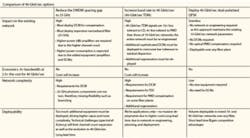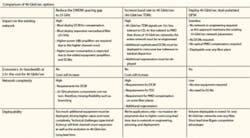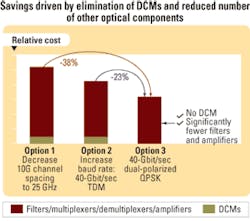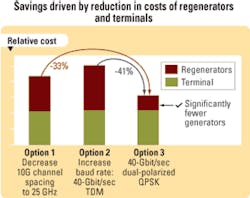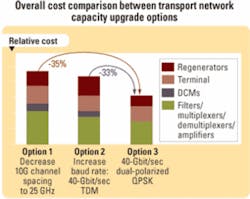Carriers have an economical option for 40G networks
by Fady Masoud
Despite the slowdown in the deployment of telecommunications equipment in the early 2000s, the demand for bandwidth didn’t stop increasing. In particular, the current explosion of video traffic has dictated new requirements for carrier networks.
Today, video is no longer restricted to our TV sets. Cell phones, PDAs, wireless home entertainment systems, laptops/desktops, and other personal electronic devices all have video capabilities offering consumers an enhanced multimedia experience anywhere, any time. Moreover, delivering video services has shifted from broadcast-only to on-demand content such as video-on-demand, free-on-demand, IPTV, peer-to-peer video conferences, and Internet video downloads, which puts more pressure on the network to provide any-to-any high-bandwidth connectivity with high quality of service.
Furthermore, enterprise LANs are now being interconnected over 10-Gbit/sec Ethernet interfaces, storage arrays are running over 10-Gbit/sec Fibre Channel (FC-1200) interfaces, and carriers’ routers are now equipped with 40-Gbit/sec interfaces. Thus, increasing the transport network’s bandwidth capacity becomes more imperative than ever.
However, this task comes with many requirements, such as:
- Minimizing the churn as a result of the increase in network capacity (more wavelengths, more equipment, different network parameters, etc.).
- Maintaining and enhancing network agility, since increasing the network capacity should not make the network rigid and static.
- Reducing opex, since increasing network capacity should enable cost savings, not cost increases.
This article discusses the different options available to service providers and network operators to evolve today’s 10-Gbit/sec transport networks to higher capacities and highlights the key considerations, pros, and cons of each option.
The introduction of 10-Gbit/sec DWDM networking in the mid-1990s disrupted the way service providers planned, built, and operated their networks. It provided new service economics (capex/opex) that resulted in the massive deployment of 10-Gbit/sec-based transport DWDM networks.
This adoption of 10-Gbit/sec DWDM triggered significant investment in network infrastructure and set refined and proven practices to design and plan the network for future growth. Therefore, the method of upgrading the network to higher capacity must meet the following requirements:
- Maximize the use of the existing network assets (fiber outlay, network elements, real estate, etc.).
- Minimize the impact on current network operations, minimize churn, and limit the capex required.
- Maintain the current, well-refined network operations processes (e.g., planning, engineering, service turn-up, troubleshooting, etc.).
- Maintain and enhance network agility.
- Account for the new drivers and proliferation of video services and high-bandwidth applications, and set in place a framework for continuous network evolution to support additional traffic and networking demands with low capex/opex and high agility.
Briefly, the migration to a higher-capacity transport network needs to be as smooth and seamless as possible. The following sections explore the various upgrade options and their advantages and challenges.
Service providers have addressed the need to increase network capacity in various ways, taking into consideration multiple factors such as cost, longevity, impact on the network, timeframe, etc. For example, maintaining the same signal format (SONET/SDH) while increasing the baud rate (e.g., OC-12/STM-4 to OC-48/STM-16, OC-48/STM-16 to OC-192/STM-64) has been one popular option given the relatively easy and cost-effective process of changing the line circuit packs following a pretested, specific procedure. Simultaneously, service providers have also increased network capacity by leveraging DWDM. So, what would be the best option to increase the capacity of the transport network while meeting all the requirements mentioned previously?
Option 1: Decrease the DWDM channel spacing. This option consists of increasing the number of DWDM wavelengths on the fiber by reducing the spacing between the multiple wavelengths (from 100 GHz to 50 GHz or from 50 GHz to 25 GHz).
Currently, 50-GHz spacing network elements (terminals, multiplexers, demultiplexers, filters, etc.) benefit from mature component manufacturing and stable operations. However, further reducing the grid spacing to 25 GHz will create the following challenges:
- A significant increase in cost for filters due to the added manufacturing complexity.
- More sophisticated modulation must be used to enable the narrower spacing, thus adding an extra cost to the transponder electro-optics at the terminal sites.
- Very often, facing a negative impact on the existing optical link budgets, which creates a requirement for additional regeneration-and increased cost and network complexity.
- Significant network re-engineering because other in-line network building blocks, such as fixed and reconfigurable optical add/drop multiplexers (OADMs and ROADMs), were designed around 100- and 50-GHz spacing.
Networking at a line rate of 40 Gbits/sec will impose significant line constraints to ensure suitable operations. In fact, 40-Gbit/sec TDM is 16× less tolerant to chromatic dispersion (CD) and 4× less tolerant to polarization-mode dispersion (PMD) than 10-Gbit/sec transmission. Moreover, the differential group delay caused by PMD will have to be minimized to a much smaller value than its 10-Gbit/sec equivalent.
These hurdles will restrict the applicability of this approach. Moreover, chromatic dispersion compensation will have to be performed at much tighter specifications than at 10 Gbits/sec, resulting in a higher capex. To allow practical deployment, tunable dispersion compensators (TDCs) and/or active PMD compensators may have to be employed, thus adding significant cost to the overall solution and increasing network complexity. In addition, the number of OADM sites will be restricted due to the smaller tolerance to filter-induced distortion. Traditional implementation of 40-Gbit/sec transponders may well restrict this option to a niche rather than a mainstream application.
Option 3: Deploy 40-Gbit/sec dual-polarized quadrature phase-shift keying (QPSK). A new innovation based on digital signal processing-enhanced optics will enable a practical 40-Gbit/sec system that allows the compensation of PMD with similar attributes to electronic compensation of chromatic dispersion (eDCO) at 10 Gbits/sec. It electronically addresses the issues of the 40-Gbit/sec TDM approaches (Option 2) listed previously, thus unlocking the possibility of massive deployment of high-capacity systems.
This method consists of encoding the 40-Gbit/sec bitstream on two 10-Gbaud QPSK signals, which are encoded onto each of the two orthogonal polarizations of the optical wavelength. At the receiver end, the incoming signal is appropriately processed using a powerful DSP algorithm. The chromatic dispersion and PMD are automatically compensated, resulting in a decoded 40-Gbit/sec signal. This approach enables convenient deployment, operations, and maintenance.
In summary, the dual-polarized QPSK approach delivers the following attributes:
- Enables cost-effective migration and better economics than increasing the capacity on 10 Gbits/sec using the previously mentioned options.
- Avoids re-engineering the network, as 40-Gbit/sec dual-polarized QPSK will operate on existing 10-Gbit/sec engineered optical line systems.
- Maintains the same spectral occupancy of each wavelength as those of existing 10-Gbit/sec line systems.
- Avoids the massive deployment of in-line or terminal dispersion compensating modules (DCMs) to overcome chromatic dispersion.
- Avoids the deployment of optical PMD compensators-a key benefit when old fiber plants must be used.
- Enables deployment over a route with mixed fiber plant.
- Exploits network agility, reduces opex due to wavelength churn, and supports a seamless evolution to adaptive all-optical networking.
Briefly, upgrading the network using 40-Gbit/sec dual-polarized QPSK allows service providers and network operators to avoid massive capex investments, maximize the utilization of their existing network assets, and maintain current network operations processes.
To clearly highlight and quantify the benefits of dual-polarized QPSK over the other two options, a case study was performed on a national optical network that spread across 32,000 km, carrying an average network fill of 25 10-Gbit/sec wavelengths per segment, with 40 add/drop sites and a mix of regional and express traffic patterns.
At the photonic layer, deploying dual-polarized QPSK enabled significant savings-as much as 38% and 23% over Option 1 and Option 2, respectively-mainly driven by the elimination of DCMs and the dramatic reduction in the number and the cost of filters, multiplexers/demultiplexers, and amplifiers as depicted in Fig. 1.
Option 2 (40-Gbit/sec TDM) required precision compensation adjustments at terminal sites due to low tolerance to residual dispersion. Moreover, driven by its engineering complexity, the reach of 40-Gbit/sec TDM was significantly lower than 40-Gbit/sec dual-polarized QPSK, hence the requirements for additional regeneration sites and associated photonic components.
Furthermore, since deploying dual-polarized QPSK will reduce the number of regenerators required, capex and opex reduction will be achieved along with network simplification. The results of the case study demonstrated 41% reduction in the cost of required terminals and regenerators when deploying dual-polarized QPSK versus 40-Gbit/sec TDM, as depicted in Fig. 2.Figure 3 provides an overall (photonic and service layers) relative cost comparison between all three options in which the advantages of dual-polarized QPSK are clearly highlighted, with 35% and 33% reductions. The table provides more details about the implementation of all three options.
While many options are available to increase network capacity, very few options allow for this task to be completed without re-engineering the network or needing massive capital investment. Leveraging dual-polarized QPSK with eDCO technology allows service providers and network operators to quadruple network capacity while leveraging existing assets and maintaining current planning and operational processes. This approach will translate to better economics and seamless evolution.Fady Masoud, P. Eng., M. Eng., is a manager in the Metro Ethernet Networks Products and Solutions Marketing group at Nortel (www.nortel.com). His area of expertise focuses around the definition, architecture, and requirements of next-generation optical platforms. He holds a bachelor’s degree in electrical engineering from Laval University (Quebec City, Quebec, Canada) and a master’s degree in systems technology (simulation of optical networks) from Superior School of Technology (Montreal, Quebec, Canada). He can be reached at [email protected]."After 'light' came, 'let there be interoperability!' I think this is just the first batch of specifications."
